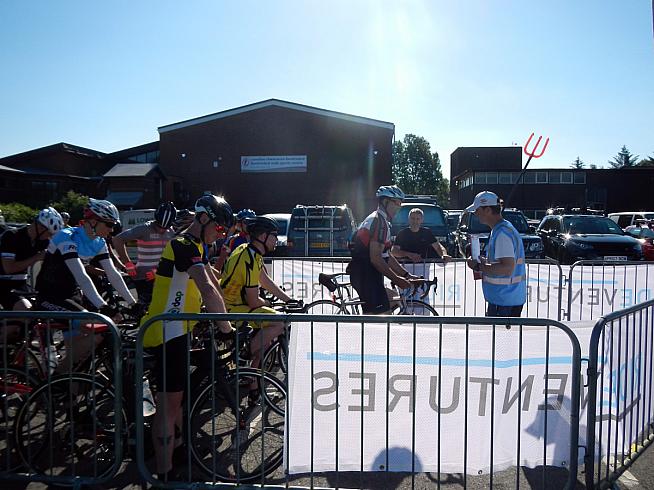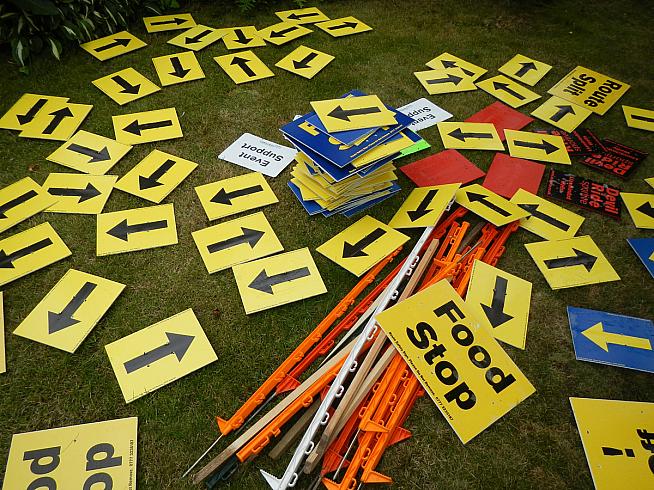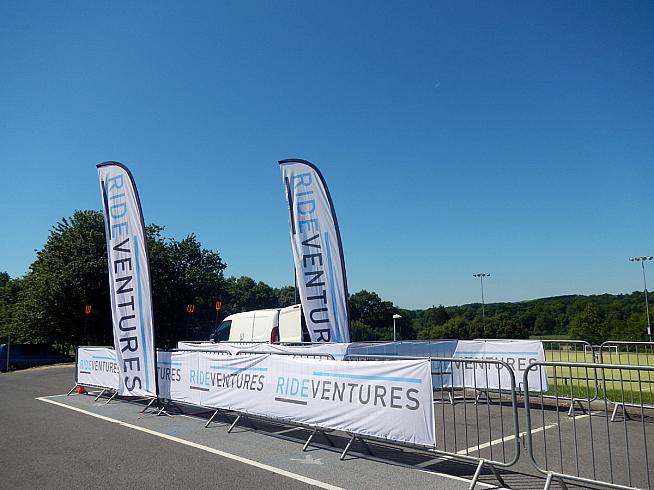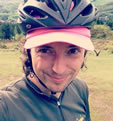Ever wondered what happens behind the scenes to put on a sportive? What the sportive rider sees on the startline is usually the result of several months of planning by the organisers, followed by at least a couple of days' build-up before event day.
From pinning up hundreds of route signs to advising participants on how to change gear, Sportive organiser Andy Dawson of Rideventures provides a behind-the-scenes look at a typical event weekend.

Countdown to a Sportive
A Sunday sportive for me as an organiser starts on Thursday, and won't be over until the Tuesday afterwards.
Thursday sees the pulling together of all the kit, the food stop boxes and water dispensers, the broom wagon maps, spare signs and first aid kits and the headquarters registration sheets - plus the whole start/finish-line set up (usually involving a massive inflatable arch and a bunch of crowd barriers) plus dressing of big flags and banners.
Friday is sign-putting-out day. The whole day is spent on the road, zip-tying the corex signs up all around the course. I can usually do about 100km a day of signing depending on the complexity of the course - an especially twisty route will take longer. The Rideventures events I do in deserted mid-Wales are much faster to sign as there's one arrow needed every 10 miles or so.
Sign positioning is a skill. The person doing it needs to be an experienced cyclist prepared to spend time getting it right at each junction. Better to put one sign up in just the right place rather than two signs in odd places where cyclists won't be looking.
With my sportives I often use my own stakes (plastic electric fence posts) to put a sign up exactly where it's needed when there's no handy roadside post available.
Saturday will involve some more signing, but hopefully also some time off to build up energy for what's going to be a long day on Sunday. One job you might not be aware of is the sign checking - driving around parts of the course that were signed on the Friday to check that the signs are still there.
On a recent sportive I found crucial turn signs in a local town had been covered up with bunches of party balloons for a nearby wedding party, and then later found a sign had been used as a notice board for another event who had put their own poster over the arrow, completely obscuring it.

Race Sportive Day
Sunday starts early, at least 5am and possibly earlier. First job is often putting out last signs - which may sound very late, but often I'll refrain from putting signs up in a town for instance, as I feel they might not survive the Saturday night revellers' sense of "fun". And then there'll be driving around more of the route to check all the signs are still out and pointing the right way.
By 7am I'm at the event HQ setting out the crowd barriers, erecting the pergolas and flags. Despite a usual 8.30 or 9am start there will always be at least one participant turning up by 7.30am - always nice to see after working alone for so long. Volunteers and day staff begin to arrive, the registration desks start giving out timing chips and the food stop people turn up, collect all they need and head off to their positions.
At Rideventures we always have a shop mechanic who gets plenty of work fixing last-minute squeaks and rattles, and other concerns from nervous participants getting ready to head off. They see all sorts of riders - at a recent event I passed by the mechanic and overheard a question from a participant, "So, how do I change gear on this bike?"
As the setting off time approaches cyclists naturally gather in front of the line. I'm usually milling around dealing with registration enquiries and generally chatting to people. Come the appointed hour we take the first 20 through to the start pen, give them a briefing - usually a mixture of obvious stuff (follow the Highway Code) and last-minute updates (a recent one - discovering on the Saturday night that an endurance equestrian event was planning to share the same route for about 3km on Sunday) - and then wave them off.
We repeat the process over and over until all have been set off. There are usually a few people who arrive late (that'll be the Sportive.com reporters - Ed) and trundle off 15 minutes after the main field.
Though you'd think we could pause for the first time, in reality we can bank on getting at least one phone call from a participant who has got lost almost immediately or whose bike isn't working properly. Usually they can be put back on track or return to HQ quite soon. Once the field of riders has got a few km away from the HQ it's time to jump in the broom wagon and head off after them.
We have one broom wagon per route - their main job is to accompany the riders, being ready to deal with problems and pick up anyone who has abandoned (usually rare, though on our recent Devil Ride we ended up with six abandoning - but that's a tough event).
Through the morning there'll be participants getting lost and needing to be directed back to the course, and there'll be bikes that aren't really up to the job and need adjustment. After all the planning and imagining of what might be the problems on an event, once it is underway new, unexpected issues arise so you need a team who can think on their feet and come up with solutions.
Also, there will be participants who are knowledgable and helpful and who naturally problem-solve - which is brilliant, as we can't be everywhere all the time. By about lunchtime things usually go quiet - the bikes that were going to go wrong have done so and the lost have been found.

Into the afternoon it's more about tea and sympathy for riders who are dealing with the challenges of the event. Participants are up against it and needing to know how much riding is left. I usually end up at the last food stop hearing stories of adventures and experiences on the road, or perhaps of friends who have gone missing that I need to search for. If some have abandoned then it's co-ordinating their return to HQ without compromising the broom wagon coverage for the event.
By late afternoon everyone is usually within 10 miles of the finish. Many are taking an extended break at the last food stop. On the recent Devil Ride in super hot weather people were commandeering the water dispenser drip buckets to use as cooling foot baths. Others were arriving soaking wet from throwing themselves in mountain streams in an effort to cool off. Many needed directions for a direct, flat return back to HQ avoiding the last hill challenge of the day.
Eventually everyone is on the road back to HQ. The broom wagon will have an accurate idea of the last four or five riders still left out (usually having noted their handlebar numbers) and once they have got back to base we can say with certainty that no one is left out.
A quick pack up - everything just thrown into vans and car boots any old way - and off we go to drive home and collapse, by 8pm on average.
You might think that is the end, but no; the next day will involve updating the website with results and event photos, getting feedback from participants and starting to thank everyone involved and/or pay them for their services. Having driven around the route on Friday, Saturday and then twice on Sunday, I tend to keep Monday stationary.
Tuesday is back out on the road collecting all the signs. Quicker than putting them out, but still most of a day at least. And then a massive unpack and sort out of all the kit ready for the next one. Tuesday evening is usually the official end of the event for me.
Andy Dawson runs Rideventures. Their next sportive is the Wolves Wenlock Sportive in Wolverhampton on 17 September. For more information and to enter, visit www.rideventures.co.uk.
0 Comments





